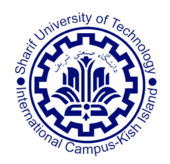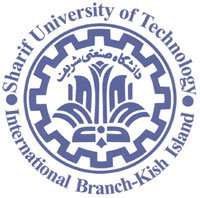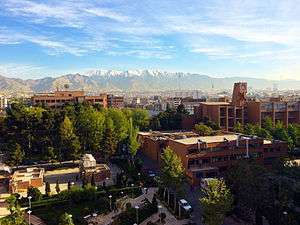Sharif University of Technology
Sharif University of Technology (SUT), Persian: Dāneŝgāhe Sannatiye Ŝarif is a public research university in Tehran, Iran and is widely considered to be the nation's leading institution for engineering and physical science disciplines. The international campus of the university is located in Kish Island, Persian Gulf.
دانشگاه صنعتی شریف Dāneŝgāhe Sannatiye Ŝarif | |
 Sharif University of Technology (SUT) coat of arms | |
Former name | Aryamehr University |
|---|---|
| Type | Public |
| Established | 1966[1] |
| Endowment | US$ 62.92 million (10 December 2014)[2] |
| President | Mahmoud Fotouhi Firouzabad |
| Vice-president | Dawood Rashtchian |
Administrative staff | 395 |
| Students | 10,251 |
| Undergraduates | 5,776 |
| Postgraduates | 4,726 |
| Location | , 35°42′6.47″N 51°21′5.18″E |
| Newspaper | Sharif Daily Scientia Iranica |
| Colours | Light Blue FireBrick |
| Athletics | 19 sports IUSF |
| Affiliations | FUIW IAU ICTP TWAS |
| Website | en.sharif.edu |
Established in 1966 under the reign of Mohammad Reza Shah Pahlavi, it was formerly named the Aryamehr University of Technology (Persian: دانشگاه صنعتی آریامهر, romanized: Dāneŝgāhe Sannatiye Āryāmehr) and for a short period after the 1979 revolution, the university was called Tehran University of Technology. Following the revolution, the university was named after Majid Sharif Vaghefi, who was one of the People's Mujahedin of Iran group's leaders who was killed by the members of a splinter group (later renamed to Peykar Organization) who had recently converted from Islam to Marxism and were adamant to forcefully change the Mujahedin's organization's ideology to Marxism.
Today, the university provides both undergraduate and graduate programs in 15 main departments. The student body consists of about 6,000[3] undergraduate students and 4,700[3] graduate students from all the 30 provinces of Iran. Funding for Sharif University is provided by the government and through private funding. Undergraduate admission to Sharif is limited to the top 800 of the 500,000 students who pass the national entrance examination administered annually by the Iranian Ministry of Science, Research and Technology.[4]
In the 2013 Academic Ranking of World Universities Engineering/Technology and Computer Sciences rankings, SUT is ranked 5th in the Middle East.[5] It is in the top 251–275 universities in the world and 37th in Asia in the 2014 Times Higher Education World University Rankings.[6][7] In the 2014 Times Higher Education top 100 for newer universities (less than 50 years old), SUT ranked 1st in the Middle East, 6th in Asia, and 27th in the world.[8]
Founded in 1966, SUT was established to train and supply part of the required expert human resources of the country on an equal level to credible universities of the world. Compared with other worldwide universities, it is a young and growing pioneer in both basic and applied sciences. The main aims of SUT are: (1) to create an organization where students can be instructed in both theoretical and applied sciences, with special emphasis on the particular needs of Islamic society; (2) to teach students the advanced knowledge and techniques required to participate in the fields of engineering and technology and to cultivate them into creative engineers, good scientists, and innovative technologists; and (3) to educate engineers who are ready to be employed, who contribute significantly to their jobs, and who have a strong sense of public responsibility and a desire to continue to learn. The emphasis is placed on the promotion of multidisciplinary research at the graduate and doctoral levels. Based on that, SUT provides a scientific and dynamic environment for those who are trying to gain knowledge. In other words, SUT is a place for those who are trying to understand and comprehend scientific realities and facts, and are trying to convey those to others.[9]
History

The university was founded in 1966 with the name Aryamehr University of Industry by Mohammad Ali Mojtahedi. At that time, there were 54 faculty members and a total of 412 students who were selected by national examination. Also, only four departments were established: Electrical, Metallurgical, Mechanical, and Chemical Engineering.[10] In 1972, Mohammad Reza Pahlavi appointed Sayyed Hosein Nasr as president of the university with the goal of modeling the school based on the Massachusetts Institute of Technology, but with roots in Iranian culture.[11][12] In 1974 a new campus of the university was established in Isfahan. But later that campus became an independent university, named Isfahan University of Technology (IUT). The emblem of IUT still closely resembles SUT's emblem .
Currently, the university has grown to an elite school with over 9000 students, 700 of whom are studying for a doctorate, and over 500 faculty members in 15 main departments.[13]
Campuses
Main campus
The main campus of the university is located in the Tarasht neighborhood, near Azadi Square, Tehran, Iran. It is located close to the Azadi Tower, which is the symbol of Tehran and one of the main transportation hubs. The endowment of Sharif University of Technology has been estimated at around $25 million.[14]
Buildings
- SUT Languages and Linguistics Center
- SUT Avicenna Building (ساختمان ابن سینا), the main classroom building named in honor of 9th century Persian scientist Avicenna
- Student Union (Shahid Rezaee Building)
- Jaber ebne hayyan Building, named in honor of 8th-century Persian scientist Jābir ibn Hayyān
- Aboreihan Birooni, named in honor of 11th-century Persian scientist Abu Rayhan Biruni (hosting departments of Mathematical Sciences and Industrial Engineering)
- Khodro
- Central library
- SUT Mosque
- The gym (I and II)
- Publication Office
- The Restaurant
International campus

coat of arms
Sharif University also has an International Campus on Kish Island in Persian Gulf. The International Campus of Sharif University of Technology was established in 2005. Today there are two faculties active in this campus: Faculty of Engineering and Science, and Faculty of Management. The campus is currently admitting students for bachelor's, master's, and Ph.D. degrees in engineering courses and a master's degree in management.
Buildings
- Central Building
- Faculty of Engineering and Science Building
- Laboratories and Workshops Building
- Language Centre Building
Academic profile

Profile
Sharif University was established in 1966 as an Engineering university with departments of Electrical, Metallurgical, Mechanical, and Chemical Engineering.[10] Currently, Sharif University has 14 science and engineering departments:
In engineering, Materials Science and Engineering, Chemical Engineering, Petroleum Engineering, Civil Engineering, Computer Engineering, Electrical Engineering, Industrial Engineering, Mechanical Engineering, and Aerospace engineering.
In science, Chemistry, Physics, Mathematical Science.
Other non-engineering departments include the School of Management and Economics, Languages and Linguistics Department, and the Department of Philosophy of Science which offers exclusively graduate degrees.
Affiliated research centers
The university has supported the establishment of Research Centers. These are usually started with a spin-off funding provided by or through university but will start to accept research and development projects from industry in their first months of establishment. Most of the employees of these centers are Sharif University students, while in some cases recent alumni or students of other universities have been recruited as well.
Following is a list of research centers affiliated with Sharif University.[15]
- Advanced Communications Research Institute
- Advanced Information and Communication Technology Research Center (AICTC)
- Alborz Observatory for high energy cosmic and gamma rays
- Biochemical and Bio-environmental Research Center
- Condition Monitoring Center (CMC)
- Entrepreneurship Center
- Economical and Industrial Studies research Center
- Electronics Research Center
- Energy Technology Research Center
- Biochemical and Bioenvironmental Research Center(B.B.R.C)
- Green University: environmental research center
- Industrial Systems Research Center
- Institute for Nanoscience and Nanotechnology
- Institute for Transportation Studies and Research
- Sharif Applied Physics Research Center
- Water, Energy and Ocean Engineering Research Center
- Sharif Accelerator
- Sharif Incubator
World Rankings
| University rankings | |
|---|---|
| Global – Overall | |
| ARWU World[16] | 401-500 (2019) |
| CWTS World[17] | 384 (2019) |
Academic Ranking of World Universities[18]
- 2015: Institutional Ranking : 401–500
- 2015: Engineering and Technology : 151–200
- 2015: Computer science : 101–150
- 2019: 432
- 2018: 471–480
- 2017: 431–440
- 2016: 471–480
- 2015: 601–650
- 2017 World Ranking: 501–600
- 2017 Asia University Rankings: 71
- 2016 World Ranking: 401–500
- 2016 Young University Rankings: 100
- 2016 Asia University Rankings: 52
- 2015 World Ranking: 301–350
- 2015 Young University Rankings: 40
- 2015 Asia University Rankings: 43
- 2014 World Ranking: 251–275
- 2014 Young University Rankings: 27
- 2014 Asia University Rankings: 37
- 2013 World Ranking: 301–350
- 2013 Young University Rankings: 47
- 2013 Asia University Rankings: 42
- 2012 World Ranking: 301–350
- 2012 Young University Rankings: 68
- 2017 Best Global Universities Ranking
- Global Ranking: 405
- Asia Ranking: 59
- Country Ranking: 1
- Engineering : 60
- Materials Science : 142
- Computer Science : 158
Research and endowment
Sharif University is a public university and its funding is provided by the government of Iran. For the top ranks of the national university entrance exam, education is free in all public universities. Those ranking lower are required to pay part or all of the tuition.
Industrial companies have supported Sharif University and provided research funding for the desired programs and projects. For instance, the Petroleum Engineering department was supported by Iran Oil industries .
Sharif University was appointed as a Center of Excellence (fa:قطب علمی) by Iran's Ministry of Science and Technology in the fields of Advanced Materials, Aerospace Systems, Biological Process Engineering, Communication, Design, Robotics and Automation, Energy Conversion, Earthquake Engineering, Mathematics, Physics, Power System Management and Control, and Telecommunications, as well as Hydrodynamics and Dynamics of Marine Vehicles.[22] This appointment is based on national standing based on research achievements and invested funding in the mentioned topics.
Student life
Political activities
Before the Islamic Revolution many political organizations including but not limited to Fadaian Khalg and People's Mujahedin of Iran active members and supporters were among students of the Sharif University. In the 14 years since its inception, many active members and supporters were arrested and killed by SAVAK among those Abdolmajid Pirzadeh Jahromi, Majid Ahmadzadeh (Fedaian Khlaq) can be named.
Through the student political movement after the 2nd of Khordad Movement, Sharif students were also actively involved. The major groups with political intentions at Sharif, during 1997–2003, were students Basij and the Association of Muslim students, briefly called Anjoman (Association). Most other smaller groups were allies of either Basij or Anjoman. Basij was a serious opposer of Mohammad Khatami, the president of the time. Whereas, Anjoman was a loyal follower. There have been several clashes between member students of the two groups. Free speech tribunes, occasionally end in harsh quarrel-like debates. However, the major clash between Anjoman and Basij occurred while the student movement was in silence in most other universities. In 2006, a serious controversy resulting in physical tensions, occurred after Basij attempted to bury bodies of unknown Martyrs of the Iran–Iraq War at the universities' Mosque court.[23]
Sharif University of Technology Association (SUTA)
Many of Sharif alumni and affiliates are spread all around the world since lots of them continue their graduate studies in Europe or North America and also some of them immigrated to these countries, therefore it is not easy to establish a local organization to be contacted by the alumni. Sharif University of Technology Association (SUTA) is a global organization that was formed in 2000 to facilitate communication and collaboration among the graduates, faculty, and staff of the Sharif University.
This non-profit organization is registered in the state of California, USA and has many chapters and affiliates around the world. Its mission is to enhance professional, academic, and social contacts among its membership, and to strengthen the ties between the association members living outside of Iran and the University.[24]
Since 2000 SUTA has had a reunion/conference every other year, in the following cities: San Diego (California), Toronto (Canada), Heidelberg (Germany), Santa Clara (California), Vancouver (Canada), Gothenburg (Sweden), Ottawa (Canada) and Milan (Italy).
Faculty and alumni
Chancellors
| Chancellor | Tenure | Alma mater | Speciality |
|---|---|---|---|
| Mohammad Ali Mojtahedi | 1965–1967 | Mechanical Engineering | |
| Fazlollah Reza | 1967 | Network and Information Theory | |
| Mohammad Reza Amin | 1968–1972 | Physics | |
| Hossein Nasr | 1972–1975 | Physics | |
| Mehdi Zarghamee | 1975–1977 | Structural Engineering | |
| Alireza Mehran | 1977–1978 | Biophysics | |
| Hossein Ali Anvari | 1978–1979 | Electrical Engineering | |
| Ali Mohammad Ranjbar | 1979–1980 | Electrical Engineering | |
| Abbas Anvari | 1980–1982 | Physics | |
| Ali Akbar Salehi | 1982–1985 | Nuclear Engineering | |
| Abbas Anvari | 1985–1989 | Physics | |
| Ali Akbar Salehi | 1989–1993 | Nuclear Engineering | |
| Mohammad Etemadi | 1993–1995 | Electronics | |
| Sayed Khatiboleslam Sadrnezhaad | 1995–1997 | Metallurgical Engineering | |
| Saeed Sohrabpour | 1997–2010 | Mechanical Engineering | |
| Reza Roosta Azad | 2010–2014 | Chemical Engineering | |
| Mahmud Fotuhi Firuzabad | 2014–current | Electrical Engineering | |
Notable alumni
The university is known for its large number of alumni who join the academic world, including the late Maryam Mirzakhani, Professor of Mathematics at Stanford University and the first female to be awarded a Fields Medal.
Several SUT alumni have been active in the industry. Akbar Torkan, director of Petro-Pars Co. and previous Transportations Minister, Ahmad Ghalebaani, former managing director of SAIPA, Salman A. Avestimehr, an American-Iranian professor and co-director of the Communication Sciences Institute at the Electrical and Computer Engineering Department of Southern California, managing director of Iran national petroleum company can be named as some of the more famous alumni.
Many of the SUT alumni have entered in politics, including Mohammad Ali Najafi former minister of higher education and member of Tehran City Council, Es'hagh Jahangiri, former Minister of Industries and Mines, Abbas Mohtaj, former commander of Iranian Navy, Mohammad Atrianfar, former head of Tehran City Council, Morteza Alviri, former Mayor of Tehran, Ali Larijani, speaker of Majlis and former presidential candidate and former head of IRIB and Mohsen Sazegara, former government official, political activist. Also, some of the opposition groups outside Iran have members who are SUT alumni. These members include Foad Mostafa Soltani, former leader of Komala political party of Iranian Kurdistan and Maryam Rajavi, president of People's Mujahedin of Iran Organization.
Multiple alumni of SUT also continued their careers as professional athletes. Having been affiliated with SUT's athletic teams, Ali Daei, former member and later head coach of Iranian national football team can be named. Adel Ferdosipour, the prominent football commentator and Elshan Moradi Chess Grandmaster are also SUT alumni.
Other publicly known figures with a Sharif related background include Peyman Yazdanian, music composer and Mohammad-Javad Larijani, director of Institute for Studies in Theoretical Physics and Mathematics.
Imprisoned human rights blogger Kouhyar Goudarzi was an aerospace student at Sharif until pressure from state security forces allegedly caused his dismissal.[25] Omid Kokabee, an Applied Physics and Mechanics alumnus,[26] was arrested while visiting Iran during his Postdoctoral research in University of Texas at Austin.[27] He was sentenced to 10 years in prison for “communicating with a hostile government” and “illegitimate/illegal earnings.”[28]
See also
- Higher education in Iran
- Pardis Technology Park
- Shahbal, unmanned aerial vehicle (UAV) developed at SUT
- Iranian Machine Design Competition
References
- "Sharif University of Technology – Introduction". Retrieved 3 February 2017.
- "Financial information". FarsNews.
- "Archived copy" (PDF). Archived from the original (PDF) on 22 July 2011. Retrieved 2 November 2009.CS1 maint: archived copy as title (link)
- "Iran Makes the Sciences A Part of Its Revolution".
- "Academic Ranking of World Universities – 2013". Shanghai Ranking Consultancy. Retrieved 23 August 2013.
- "Sharif University of Technology". Retrieved 3 February 2017.
- "World University Rankings". 13 April 2015. Retrieved 3 February 2017.
- "150 Under 50 Rankings". 13 April 2015. Retrieved 3 February 2017.
- Guerrero, Maribel; Urbano, David; Salamzadeh, Aidin (1 January 2014). "Evolving Entrepreneurial Universities: Experiences and Challenges in the Middle Eastern Context". doi:10.13140/rg.2.1.4554.7363. Cite journal requires
|journal=(help) - Mirzayi, Mohammad (2005). Sharif University of Technology Booklet (in Persian). Sharif University Press.
- "Biography / Dr. Seyyed Hossein Nasr". Retrieved 28 May 2008.
- Leslie, Stuart W.; Robert Kargon (2006). "Exporting MIT: Science, Technology, and Nation-Building in India and Iran". Osiris. 21 (1): 123. doi:10.1086/507138.
- "Sharif University Introduction". Retrieved 13 December 2015.
- "Sharif University International Campus Website". Retrieved 17 November 2008.
- "Research Centers". Sharif University Website. Archived from the original on 25 February 2004.
- [Academic Ranking of World Universities 2019 http://www.shanghairanking.com/ARWU2019.html]
- [CWTS Leiden Ranking 2019 https://www.leidenranking.com/ranking/2019/list]
- "Sharif University of Technology | Academic Ranking of World Universities - 2019 | Shanghai Ranking - 2019". www.shanghairanking.com. Retrieved 17 March 2020.
- "Sharif University of Technology". Top Universities. 16 July 2015. Retrieved 31 May 2017.
- "Home". Retrieved 3 February 2017.
- https://www.usnews.com/
- "Sharif University of Technology – Centers of Excellence". Retrieved 3 February 2017.
- "Iran: Students Protest Burials Of War Dead On Tehran Campuses". Radio Free Europe, Radio Liberty (RFEL). Retrieved 28 May 2008.
- "SUTA Vision and Mission". Retrieved 22 February 2011.
- "Kouhyar Goudarzi: "I Won't Be Released Any Time Soon," Trial Date Unknown". International Campaign for Human Rights in Iran. 12 April 2010. Retrieved 1 January 2012.
- "Omid Kokabee (personal homepage)". Archived from the original on 19 September 2012. Retrieved 12 April 2013.
- Shuster, Mike (7 October 2011). "Iran Charges Student Who Was In the U.S." NPR.
- Maly, David (8 January 2013). "UT student Omid Kokabee gains more international support amid prison sentence". The Daily Texan. Retrieved 12 April 2013.
External links
| Wikimedia Commons has media related to Sharif University of Technology. |